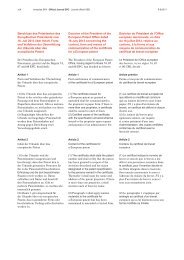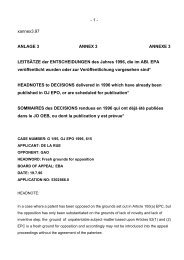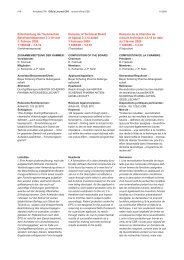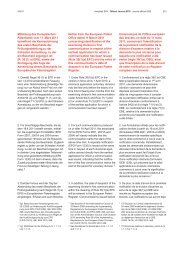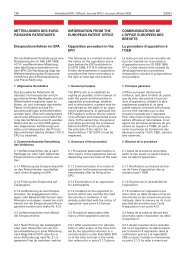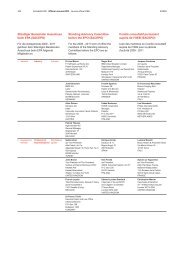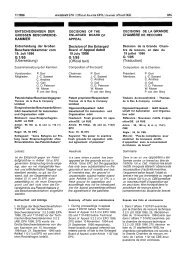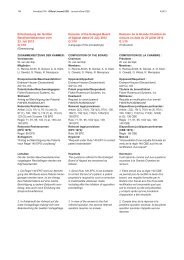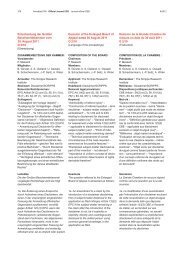Sonderausgabe 1 - European Patent Office
Sonderausgabe 1 - European Patent Office
Sonderausgabe 1 - European Patent Office
You also want an ePaper? Increase the reach of your titles
YUMPU automatically turns print PDFs into web optimized ePapers that Google loves.
2007 <strong>Sonderausgabe</strong> Nr. 1 ABl. EPA / Special edition No. 1 OJ EPO / Edition spéciale n° 1 JO OEB 173<br />
(2) Der Präsident des Europäischen<br />
<strong>Patent</strong>amts bestimmt, in welcher Weise<br />
die öffentliche Bekanntmachung erfolgt<br />
und wann die Frist von einem Monat zu<br />
laufen beginnt, nach deren Ablauf das<br />
Schriftstück als zugestellt gilt.<br />
Regel 130<br />
Zustellung an Vertreter<br />
(1) Ist ein Vertreter bestellt worden, so<br />
werden die Zustellungen an den<br />
Vertreter gerichtet.<br />
(2) Sind mehrere Vertreter für einen<br />
Beteiligten bestellt, so genügt die Zustellung<br />
an einen von ihnen.<br />
(3) Haben mehrere Beteiligte einen<br />
gemeinsamen Vertreter, so genügt die<br />
Zustellung an den gemeinsamen<br />
Vertreter.<br />
Kapitel V<br />
Fristen<br />
Regel 131<br />
Berechnung der Fristen<br />
(1) Die Fristen werden nach vollen<br />
Tagen, Wochen, Monaten oder Jahren<br />
berechnet.<br />
(2) Bei der Fristberechnung wird mit<br />
dem Tag begonnen, der auf den Tag<br />
folgt, an dem das Ereignis eingetreten<br />
ist, aufgrund dessen der Fristbeginn<br />
festgelegt wird; dieses Ereignis kann<br />
eine Handlung oder der Ablauf einer<br />
früheren Frist sein. Besteht die Handlung<br />
in einer Zustellung, so ist das maßgebliche<br />
Ereignis der Zugang des zugestellten<br />
Schriftstücks, sofern nichts<br />
anderes bestimmt ist.<br />
(3) Ist als Frist ein Jahr oder eine Anzahl<br />
von Jahren bestimmt, so endet die Frist<br />
in dem maßgeblichen folgenden Jahr in<br />
dem Monat und an dem Tag, der durch<br />
seine Benennung dem Monat und durch<br />
seine Zahl dem Tag entspricht, an dem<br />
das Ereignis eingetreten ist; hat der<br />
betreffende nachfolgende Monat keinen<br />
Tag mit der entsprechenden Zahl, so<br />
läuft die Frist am letzten Tag dieses<br />
Monats ab.<br />
(2) The President of the <strong>European</strong><br />
<strong>Patent</strong> <strong>Office</strong> shall determine how the<br />
public notice is to be given and the<br />
beginning of the period of one month on<br />
expiry of which the document shall be<br />
deemed to have been notified.<br />
Rule 130<br />
Notification to representatives<br />
(1) If a representative has been<br />
appointed, notifications shall be<br />
addressed to him.<br />
(2) If several representatives have been<br />
appointed for a single party, notification<br />
to any one of them shall be sufficient.<br />
(3) If several parties have a common<br />
representative, notification to the<br />
common representative shall be sufficient.<br />
Chapter V<br />
Time limits<br />
Rule 131<br />
Calculation of periods<br />
(1) Periods shall be laid down in terms of<br />
full years, months, weeks or days.<br />
(2) Computation shall start on the day<br />
following the day on which the relevant<br />
event occurred, the event being either a<br />
procedural step or the expiry of another<br />
period. Where the procedural step is a<br />
notification, the relevant event shall be<br />
the receipt of the document notified,<br />
unless otherwise provided.<br />
(3) When a period is expressed as one<br />
year or a certain number of years, it shall<br />
expire in the relevant subsequent year in<br />
the month having the same name and<br />
on the day having the same number as<br />
the month and the day on which the said<br />
event occurred; if the relevant subsequent<br />
month has no day with the same<br />
number, the period shall expire on the<br />
last day of that month.<br />
(2) Le Président de l’<strong>Office</strong> européen<br />
des brevets détermine les modalités de<br />
la publication ainsi que le point de départ<br />
du délai d’un mois à l’expiration duquel<br />
le document est réputé signifié.<br />
Règle 130<br />
Signification au mandataire ou au<br />
représentant<br />
(1) Si un mandataire a été désigné, les<br />
significations lui sont faites.<br />
(2) Si plusieurs mandataires ont été<br />
désignés pour une seule partie, il suffit<br />
que la signification soit faite à l’un d’entre<br />
eux.<br />
(3) Si plusieurs parties ont un représentant<br />
commun, il suffit que la signification<br />
soit faite au représentant commun.<br />
Chapitre V<br />
Délais<br />
Règle 131<br />
Calcul des délais<br />
(1) Les délais sont fixés en années,<br />
mois, semaines ou jours entiers.<br />
(2) Le délai part du jour suivant celui où<br />
aeulieul’événement par référence<br />
auquel son point de départ est fixé, cet<br />
événement pouvant être soit un acte,<br />
soit l’expiration d’un délai antérieur. Sauf<br />
s’il en est disposé autrement, lorsque<br />
l’acte est une signification, l’événement<br />
considéré est la réception de la pièce<br />
signifiée.<br />
(3) Lorsqu’un délai est exprimé en une<br />
ou plusieurs années, il expire, dans<br />
l’année ultérieure à prendre en considération,<br />
le mois portant le même nom et le<br />
jour ayant le même quantième que le<br />
mois et le jour où ledit événement a eu<br />
lieu ; si le mois ultérieur à prendre en<br />
considération n’a pas de jour ayant le<br />
même quantième, le délai considéré<br />
expire le dernier jour de ce mois.



